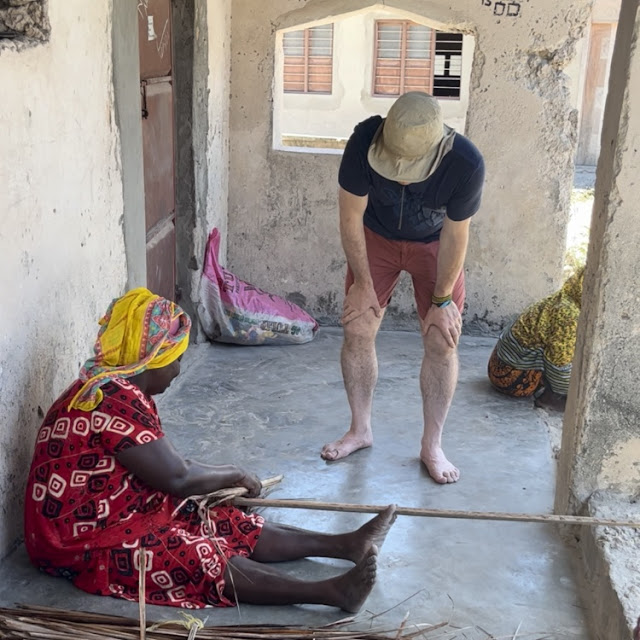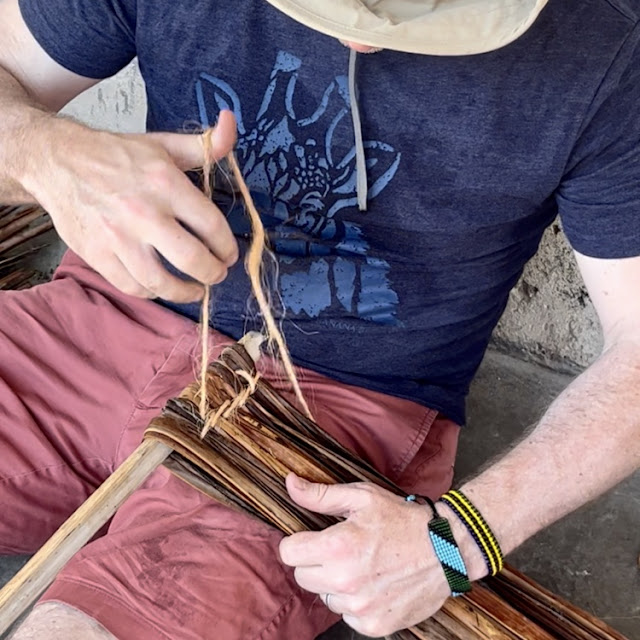Because we didn't want to just hang out in our hotel and eat food cooked especially for us and sit on a lounge chair and sip drinks and spend whatever time we felt like each day cooling off in the hotel pool gorgeously set between majestic mature palm trees (jealous, yet?), we decided to take a trip of some type every day we were staying there to experience something about Zanzibar outside the four walls of our hotel property. The first day we took a trip to the Jozani Forest to see a ton of monkeys. The next day we got up early and went dolphin watching. For our last full day on the island we wanted to connect with the people who actually live on the island today. So, we made arrangements with a guy named Ameir to have him take us to see some of the women he grew up with in the town of Jambiani, which was just next to our hotel.
 |
| The streets of Jambiani, Zanzibar. |
Believe it or not, people lived on Zanzibar before almost the whole east coast of the place was built out with resorts to serve tourists. And while it may seem to us like those people were living in a place where life is easy and always sunny (because it is for those of us who visit there today...), that's probably not true. For the men on Zanzibar, life every day involved getting up early, battling the Indian Ocean and finding enough food in a boat to feed you and your family. For the women who were left behind, well they just needed to take care of everything else. Cooking? Sure. Raising kids? Definitely. Making and/or repairing clothes? Absolutely. Minor or major house repair, including reroofing said houses? Yes, that too. Making rope for the men who were out fishing all day? Getting the picture, yet? Everything.
For some people on Zanzibar, that reality still exists today. Men still fish or work in hotels or resorts or take tourists all over the island to do whatever tourists love to do. Women still do everything else. We thought it might be both important and enjoyable to see that side of life on Zanzibar. So we left our gorgeously appointed hotel grounds where the sand is raked each morning and breakfast is ready whenever you need it to be and we spent a couple of hours with Ameir. And some of the women who have taken care of things for him in his life.
 |
| Gathering coconut shells. |
Ameir picked us up from our hotel; took us to the ocean where we found two piles of rocks just submerged below the water level; grabbed a coconut shell from beneath one of those piles; and took us to meet his grandmother. If I have ever had a stranger start to a tour while I've been on vacation, I can't recall it.
If you asked me today how people in Europe or the United States started making rope, I would not be able to tell you. I'd have to guess and I'm sure I'd be totally and completely wrong. But if you asked me how people in Zanzibar started making rope, I could tell you without a problem: they used (and still do use) coconut shells.
Ameir handed the coconut shell that he picked up from the ocean to his grandmother who then proceeded to beat the thing to a pulp with a wooden stick. Literally. When she was done, she had a mass of coconut shell length, ugly, orange fibers. Ameir referred to this as "Donald Trump's hair" and I really have no issue with that. She then proceeded to make the coconut into rope by grabbing a right-sized bunch of fibers, folding it in half, and rolling it on her leg until it bonded together into a rope. Boom! That's how rope gets made in Zanzibar. Coconut shell, water, stick, rolling on legs. Need rope for fishing or household goods? That's how it's done.
As part of our experience, we were allowed to try this technique. And by "we", I mean my wife. Rolling coconut fibers on one's leg pulls the hairs out. And, not wishing to have my legs waxed by coconut shell fibers, I watched. If you are thinking of opening some sort of business in Zanzibar to make rope out of coconuts, you'll need patience. Soak time in the ocean is 90 days. Coconuts are tough!
 |
| Making rope the old-fashioned way. |
I don't know what the cost-benefit analysis of making rope from coconut shells vs. buying one made either in Zanzibar or from some other part of the world but today, ropes are woven into mats and other goods which are sold for income. This is real world stuff, both through the centuries that people have been making rope from coconuts and today by creating a source of income for people who traditionally were not part of a market driven economy.
This idea is also perhaps especially vital for women who have started their own businesses growing seaweed. While seaweed as a food source was introduced to Zanzibar by the Japanese in the late 1800s, the leveraging of this crop which is grown in parts of the ocean which can be accessed on foot (women in Zanzibar were not traditionally taught to swim) is relatively recent. Since this practice is clearly traditionally "women's work", it has allowed women to transform a traditional practice into a modern business free from the influence of men. I think that's pretty cool.
 |
| Seaweed from the Indian Ocean. It's surprisingly stiff and not salty. Yes, I ate some right from the sea. |
I watched. I learned.
A roofing component in Zanzibar construction involves a long linear element to which are attached a series of leaves. Stack these like tiles on a sloped roof on top of a building close enough to one another and the leaves act like a continuous membrane that sheds water pretty efficiently. I can't say whether this construction is totally waterproof, mostly because I wasn't in a building roofed with these materials while it was raining. Nor can I say if there is something else like a membrane placed below a roof made of leaves. I just made a part of a single element. We didn't actually put these things in place on a home under construction or anything.
Take the long spine that runs down the center of the palm leaf (apparently it's called an axis; I looked that up when I got home) and use it as the spine around which all the leaves are attached. Then take three palm leaves (the things that are attached to the axis of the palm on a palm tree), fold them in half and place them so that the center of the leaf is against the axis. Then take your rope (perhaps made from the Donald Trump's hair from the coconut shells), run it across the top side of the leaves, thread it under the leaves on the axis side of the leaves and pull tight. Repeat. Repeat. Repeat. Until you have an entire section of roofing.
Then do it again. And again. And again. This may not seem like an efficient way to make a house but when it's the only way you have of making a roof and you have a ton of palm trees all around you, it's a necessary task. Needless to say, I put about 12 leaves in place and then was ready to be done with that job. After all, I was on vacation.
We needed something the last day we spent in Zanzibar that got us out of the hotel for a couple of hours and really connected us with someone local. Spending a couple of hours with Ameir and the women he grew up with got us all that. This was totally different than anything else we did on the east coast of Zanzibar. It wasn't focused on food or wildlife or the tourist industry machine that runs the Indian Ocean side of the island. While acknowledging that we did pay for this tour and were picked up and dropped back off at our beachside hotel, this felt more real.
And if I'm every marooned on a desert island full of palm trees and I need to make some rope and some shelter, I'm pretty much all set. As long as I can survive for 90 days for the coconuts to get soft enough to get me the raw material for the rope, that is.







No comments:
Post a Comment